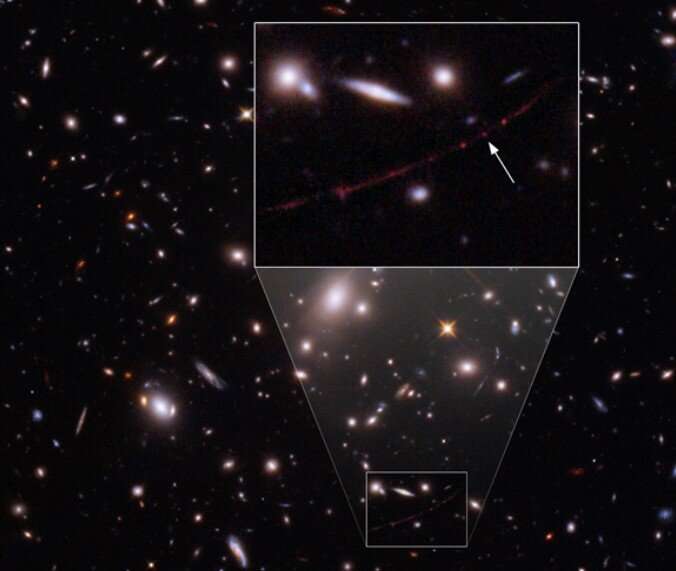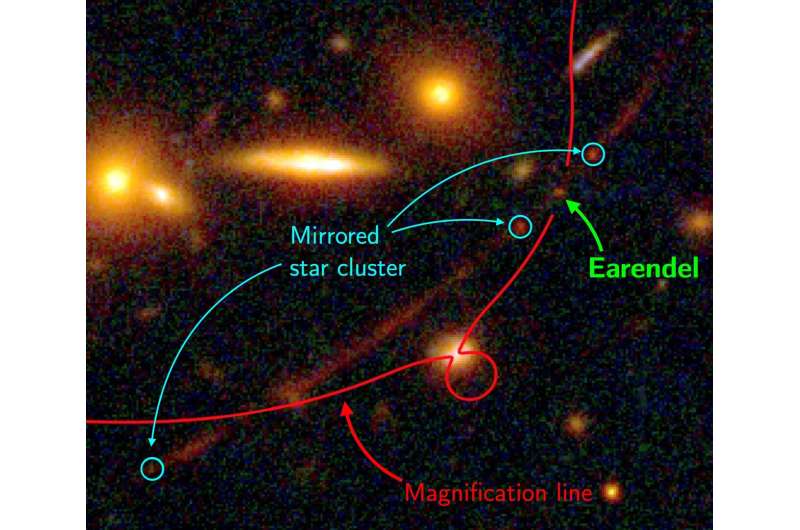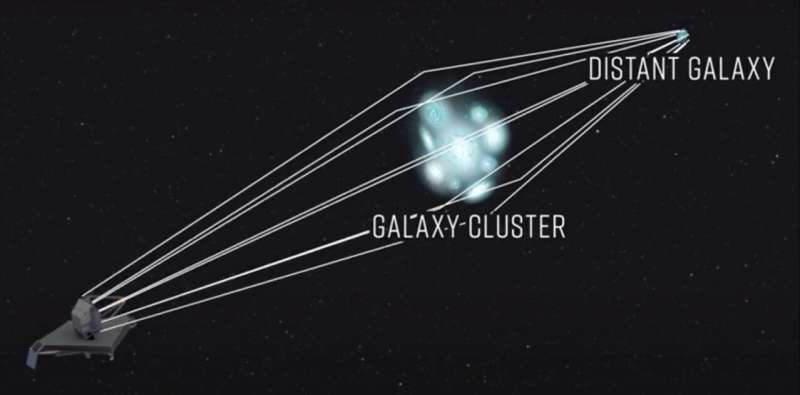
Posted on 03/30/2022 8:24:51 PM PDT by LibWhacker

Closeup of the region on the sky, 1/250 of a degree across, where the gravity of a foreground cluster of galaxies magnifies the distant background star—nicknamed Earendil—thousands of times.
With a fortuitous lineup of a massive cluster of galaxies, astronomers discovered a single star across most of the entire observable Universe. This is the farthest detection of a single star ever. The star may be up to 500 times more massive than the Sun. The discovery has been published today in the journal Nature.
Gazing at the night sky, all the stars that you see lie within our own galaxy, the Milky Way. Even with the most powerful telescopes, under normal circumstances individual stars can only be resolved in our most nearby galactic neighbors. In general, distant galaxies are seen as the blended light from billions of stars.
But with the marvelous natural phenomenon known as "gravitational lensing," astronomers from the Cosmic Dawn Center at the Niels Bohr Institute and DTU Space were nevertheless able to detect a distance where even detecting entire galaxies is challenging.
A cosmic telescope predicted by Einstein
Among the wonders predicted by Einstein's theory of relativity is the ability of mass to "curve" space itself. As light passes close to massive objects, its path follows the curved space and changes direction. If a massive object happens to lie between us and a distant background source of light, the object may deflect and focus the light toward us as a lens, magnifying the intensity.
Galaxies magnified several times are routinely discovered by way of this method. But in an astounding cosmic coincidence, the galaxies in a cluster named WHL0137-08 happened to line up in such a way as to focus the light of a single star toward us, magnifying its light thousands of times.
A combination of this gravitational lens and nine hours of exposure time with the Hubble Space Telescope enabled an international team of astronomers to detect the star.

Close-up of the tiny region where Earendel happened to fall right on top of the narrow line where the magnification increases by (tens of) thousands of times. A cluster of many stars is seen slightly offset from the line, resulting in a much smaller magnification but instead being mirrored by gravity.
Earendel—the morning star
The astronomers nicknamed the star Earendel, from the Old English word meaning "morning star," or "rising light." They calculate that the star it at least 50 times as massive as our Sun, possibly up to 500, and millions of times as bright.
Besides being an astonishing achievement in itself, the observation of Earendel offers a unique possibility of investigating the early Universe:
"As we peer into the cosmos, we also look back in time, so these extreme high-resolution observations allow us to understand the building blocks of some of the very first galaxies," explains Victoria Strait, postdoc at the Cosmic Dawn Center, Copenhagen, and a collaborator and co-author of the study. She elaborates:
"When the light that we see from Earendel was emitted, the Universe was less than a billion years old; only 6% of its current age. At that time it was 4 billion lightyears away from the proto-Milky Way, but during the almost 13 billion years it took the light to reach us, the Universe has expanded so that it is now a staggering 28 billion lightyears away."
The previous record is a star seen when the Universe was around a third of its current age, at which time most of its structure had already formed and evolved. So Earendel is indeed a ground-breaking record.

A massive galaxy cluster focuses and magnifies the light from a background galaxy
A target for the James Webb Space Telescope
To measure the brightness of Earendel, the astronomers constructed a physical model of the gravitational lens. The exact nature of the light source depends on their model, but when the astronomers are so certain that the little dot is in fact a single star, it is in part because many different models all give roughly the same answer.
Nevertheless, Earendel could in principle be more than one star, located very close to each other. To test whether this is the case, the team applied for—and were awarded—observing time with the recently launched James Webb Space Telescope.
"With James Webb, we will be able to confirm that Earendel is indeed just one star, and at the same time quantify which type of star it is," says Sune Toft, leader of the Cosmic Dawn Center and professor at the Niels Bohr Institute, who also participated in the study. "Webb will even allow us to measure its chemical composition. Potentially, Earendel could be the first known example of the Universe's earliest generation of stars."
“I’m not saying it’s aliens, but it’s aliens.”
Cool website. Gotta love all the times the line “We still have no good theory to explain this value.” is used.
A beautiful sentiment, Dogbert. Thankyou.
Huh? The universe is 13.8 billion years since the "Big Bang" (give or take 0.02 billion years). So the universe is "expanding" at the speed of light? This sounds more like 'Alice in Wonderland' than Physics.
That works only because they're travelling at speeds well below the speed of light.
Inflation.
(IIRC it was really 4 quadrants, but, I digress.)
Well, actually it's a bit more complicated than that.
Well, actually it's a bit more complicated than that.
Well, actually...
I get that, but the light we see from the car can’t be more than one hour old and light has a fixed speed.
Best answer yet 🤣
These scientists just make this stuff up.
Of course, I hadn’t thought of that.
Something’s amiss. Or is the ‘science settled’ on astrophysics, too?
= = =
Inflation.
Ice Cream package getting smaller.
Universe getting older.
Zoroastrian Faith and Philosophy
Zarathustra’s philosophy 4,000 years ago was that the Lord of Cosmos galactic width extends more than 36 milliard (milliard = one thousand million = one billion) (36 thousand million = 36 billion) light years ...
Our knowledge of the size of the universe went for almost 14 billion LY to 28 billion LY. Only another 8 billion LY to go ...
When they have a cogent explanation for where all the matter which goes into a black hole ends up, wake me.
It likely exploded less than about 100,000,000 years after it was formed, probably 13 billion years ago.
Same place missing socks go - the lost socks dimension.
The human race is like blind squirrels trying to find nuts when it comes to the origins of the universe. We grope in the dark, occasionally finding a nugget that seems to explain something, but later is revealed to be just the tip of something much large and more complex. The Webb TScope is just as likely to create more questions as it will reveal answers. Good hunting folks.
There are only 2 of us in the house, and I do my own laundry.
I swear there’s a black hole in my dryer…
GK Chesterson wrote that the Universe is the only hole big enough for man to put his head in. I always liked that thought.
Disclaimer: Opinions posted on Free Republic are those of the individual posters and do not necessarily represent the opinion of Free Republic or its management. All materials posted herein are protected by copyright law and the exemption for fair use of copyrighted works.